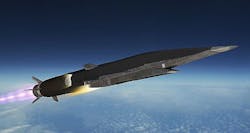Lockheed Martin hypersonic missile may achieve speeds of 3,800 miles per hour -- or one mile per second
EGLIN AIR FORCE BASE, Fla. – U.S. Air Force airborne weapons experts are looking to Lockheed Martin Corp. to develop and test a hypersonic missile able to achieve speeds of about five times the speed of sound after launch from jet fighters and bombers.
Officials of the Air Force Life Cycle Management Center (AFLCMC) Armament Directorate at Eglin Air Force Base, Fla., announced a $928 million contract Wednesday to the Lockheed Martin Space Systems segment in Huntsville, Ala., for the Hypersonic Conventional Air-Launched Strike Weapon program.
The Air Force is asking Lockheed Martin to develop and integrate an air-launched hypersonic conventional stand-off strike weapon for fighter and bomber aircraft.
The hypersonic conventional strike weapon will provide a prompt precision-strike capability against high-value, time-critical fixed and relocatable surface targets, Air Force officials say.
Related: Russia, China eclipse U.S. in hypersonic missile technologies, prompting fears
The hypersonic weapon, which is expected to reach speeds of about 3,800 miles per hour, will use Global Position System (GPS) and inertial guidance system (INS) navigation and terminal guidance with a government-furnished warhead.
The contract covers development, integration, and test through full-scale development, which military leaders call engineering and manufacturing development (EMD).
Hypersonic weapons will be able to travel at about one mile per second -- a speed that makes the munition very difficult to defend against. Deployed warships, for example, typically would have less than one minute to react after detecting the launch of hypersonic missiles fired their way.
Related: Orbital ATK to help U.S. military develop hypersonic propulsion for aircraft and missiles
For this contract Lockheed Martin prevailed over other U.S. defense contractors that included the Boeing Co.; Northrop Grumman Corp., Raytheon Co., and Orbital ATK, which Air Force officials say are the only companies capabilities necessary to undertake this project without unacceptable delays. Three of these five companies submitted formal proposals.
Lockheed Martin was able to demonstrate to the Air Force sufficient capabilities in hypersonic aerodynamics; aero-thermal protection systems; solid rocket motors; warhead and missile integration; advanced hypersonic guidance, navigation, and control; and aircraft integration.
Air force officials particularly are interested in rapid development and fielding of the Hypersonic Conventional Air-Launched Strike Weapon. This project began in June 2017 with a sources-sought notice from the Air Force to a limited number of defense prime systems integrators.
Related: The hypersonic arms race heats up
Military leaders have a strong sense of urgency in developing hypersonic weapons to counter promising developments in hypersonic technology in China and Russia. Some experts content the U.S. military lags behind Russia and China in hypersonic weapons development.
The U.S. Navy's most advanced anti-ship missile program -- the Lockheed Martin Long Range Anti-Ship Missile (LRASM) -- for example, is being designed as a subsonic munition.
On this hypersonic weapons contract Lockheed Martin will do the work in Huntsville, Ala. The duration of the contract was not specified. For more information contact Lockheed Martin Space Systems online at www.lockheedmartin.com/en-us/capabilities/space.html, or the Air Force Life Cycle Management Center Armament Directorate at www.eglin.af.mil/Units/Armament-Directorate.
Ready to make a purchase? Search the Military & Aerospace Electronics Buyer's Guide for companies, new products, press releases, and videos

